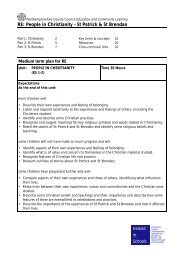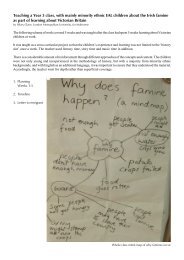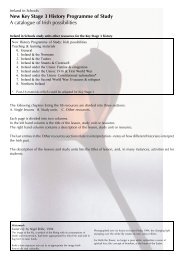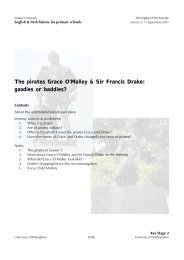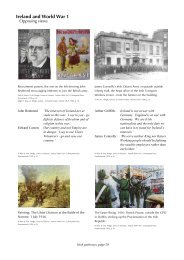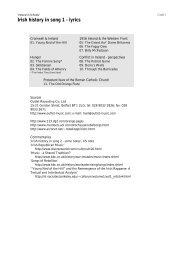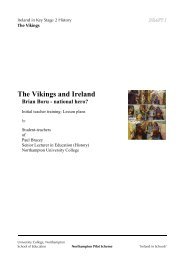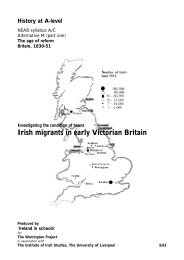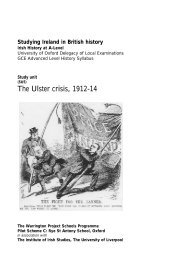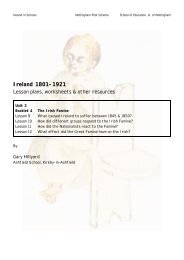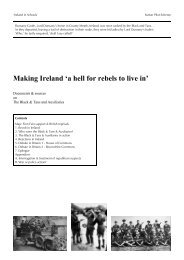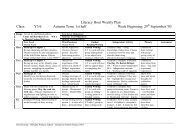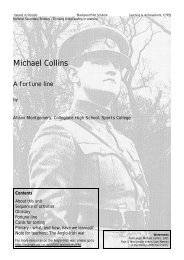Enjoying Irish literature in secondary schools - Ireland in Schools
Enjoying Irish literature in secondary schools - Ireland in Schools
Enjoying Irish literature in secondary schools - Ireland in Schools
Create successful ePaper yourself
Turn your PDF publications into a flip-book with our unique Google optimized e-Paper software.
1. New <strong>Irish</strong> writ<strong>in</strong>g for children & young adults<strong>Irish</strong> drama and poetry have long graced the curriculum <strong>in</strong> <strong>schools</strong> <strong>in</strong> Brita<strong>in</strong>, particularly at GCSE and A-level,and cont<strong>in</strong>ue to do so. Now, however, new <strong>Irish</strong> writers are produc<strong>in</strong>g a wide range of fiction for children andyoung adults.Deliver<strong>in</strong>g - & enrich<strong>in</strong>g - National StrategiesIn pilot schemes run by ‘<strong>Ireland</strong> <strong>in</strong> <strong>Schools</strong>’ (IiS), <strong>Irish</strong> texts are help<strong>in</strong>g teachers to meet and go beyond therequirements of government strategies. They enriched the National Literacy Strategy at Key Stages 1 & 2 andare now do<strong>in</strong>g the same for <strong>secondary</strong> English.Teach<strong>in</strong>g schemesTeach<strong>in</strong>g schemes on <strong>Irish</strong> texts are <strong>in</strong>cluded on the IiS CD-ROM E01 along with other resources for English,Drama and Literacy for Key Stage 3 to A-level. All schemes have been developed by practis<strong>in</strong>g teachers andproved <strong>in</strong> the classroom.Broad appealThe success of these schemes lies <strong>in</strong> the excellence of the teach<strong>in</strong>g and <strong>in</strong> the range and quality of <strong>Irish</strong>children’s <strong>literature</strong> - myths & legends, historical novels, fantasy and contemporary realism. There are booksand stories to suit all ages and abilities, allow<strong>in</strong>g all to participate <strong>in</strong> a common project. All can enjoy read<strong>in</strong>gbooks which are suited to their <strong>in</strong>dividual <strong>in</strong>terests and abilities.Fantasy - for boysPilot <strong>schools</strong> have had their share of reluctant readers among the boys, but they all respond to tales of fantasyby <strong>Irish</strong> authors, such as Eo<strong>in</strong> Colfer’s Artemis Fowl.Myths & legendsThe comb<strong>in</strong>ation of the heroic and the magical, and the feist<strong>in</strong>ess of <strong>Irish</strong> hero<strong>in</strong>es, appealsacross gender and age and ability ranges. Among the illustrated collections, the favouriteis Sionbhe Lally’s lavish Favourite <strong>Irish</strong> Fairy Tales.Liam Mac Uist<strong>in</strong>’s Celtic Magic Tales shows magical powers gett<strong>in</strong>g people <strong>in</strong>to and out oftrouble (‘Quest for Aideen’); heroes, like Cuchula<strong>in</strong>n, <strong>in</strong>volved <strong>in</strong> deadly or humourouscontests; and love br<strong>in</strong>g<strong>in</strong>g tragedy - ‘Deirdre & the Sons of Usnach’, an epic story ofbravery, loyalty and honour m<strong>in</strong>gled with jealousy, betrayal and death - an early exampleof tragic love <strong>in</strong> European <strong>literature</strong>.Historical novels<strong>Ireland</strong>’s history - generally flashpo<strong>in</strong>t periods when conflict<strong>in</strong>g ideologies meet and when conflict<strong>in</strong>g loyaltiesare tested - rema<strong>in</strong>s a focus of <strong>Irish</strong> writ<strong>in</strong>g for the young. Very popular is Under the Hawthorn Tree by MaritaConlon-McKenna, the first of an award-w<strong>in</strong>n<strong>in</strong>g trilogy. It is a gripp<strong>in</strong>g story of love, loyalty and courage set<strong>in</strong> the devastation of the <strong>Irish</strong> Fam<strong>in</strong>e of the 1840s, when three children were left to fend for themselves. AChannel 4 film of the book helps to ease the way for reluctant or slower readers.Contemporary realismMore writers are now portray<strong>in</strong>g a vision of the country <strong>in</strong> which their young readers arethemselves grow<strong>in</strong>g up, free from the ‘Oirish’ stereotyp<strong>in</strong>g.Some of this rema<strong>in</strong>s ‘middle-class <strong>literature</strong>’, featur<strong>in</strong>g at least one work<strong>in</strong>g parent, withaspirations to education and a positive social ideology for teenagers to rebel aga<strong>in</strong>st. 1 Othernovels, though, address less comfortable aspects, ‘the grow<strong>in</strong>g underbelly’, of modern <strong>Irish</strong>society. 21 Such as Marilyn Taylor’s ‘Jackie trilogy’, Jane Mitchell’s When Stars Stop Sp<strong>in</strong>n<strong>in</strong>g and Eo<strong>in</strong> Colfer’s Benny and Omar and Benny and Babe.2 Such as ‘the new not-work<strong>in</strong>g class’ (Siobhán Park<strong>in</strong>son’s Break<strong>in</strong>g the Wishbone), foster families (Park<strong>in</strong>son’s The Moon K<strong>in</strong>g (E31), dysfunctional families (Marita ConlonMcKenna, No Goodbye), prejudice aga<strong>in</strong>st gypsies (Conlon McKenna, The Blue Horse) and political violence (Mark O’Sullivan, Silent Stones).IiS, Enrich<strong>in</strong>g English <strong>in</strong> <strong>secondary</strong> <strong>schools</strong>, 2



